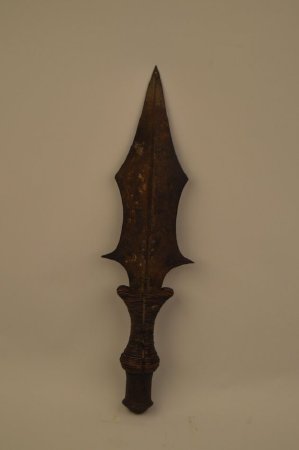Title:
Kuba / Nkutshu Dagger
Object Name:
Knife, Kuba
Other Name:
Knife / Dagger, Kuba
Place of Origin:
Kuba, Democratic Republic of Congo, Africa
Provenance:
Aboriginal Indigenous Art.
H = 16—1/2"
W = 4—1/4"
D = 1—1/2"
Nkutshu subgroup: c. 1920, (late 19th—early 20th century).
Knives, daggers and swords from the Kuba people are used as prestige items. Historical documents indicate that quantities of them were brought to the Congo by Portuguese and Dutch traders beginning around the 16th century. Many weapons were then forged by Congolese blacksmiths to emulate foreign examples. They were reserved for nobles and used for important ceremonial occasions.
Knives, axes, currency blades and spears, all made of forged iron, attest to the skills in metal of the Kuba peoples of central Africa. Most exhibit an inventive variety of form and workmanship far beyond what was functionally necessary.
In Africa, knives and other weapons can have practical uses in hunting, farming and warfare. However, the weapons that were most often collected by foreigners——and that were also prized and displayed in Africa——were those whose use was ceremonial and status display. The three—pointed dagger of the Nkutshu is a particularly distinctive blade, but it is the end of the hilt that one notices when the knife is held. The cube that tenons into the base is extraordinarily heavy, made of high—grade iron. Colonial collectors told stories about how the Nkutshu would drop these hilt first from trees, though this seems unlikely. This amount of refined iron suggests a type of stored wealth while the form recalls an anvil.
H = 16—1/2"
W = 4—1/4"
D = 1—1/2"
Nkutshu subgroup: c. 1920, (late 19th—early 20th century).
Knives, daggers and swords from the Kuba people are used as prestige items. Historical documents indicate that quantities of them were brought to the Congo by Portuguese and Dutch traders beginning around the 16th century. Many weapons were then forged by Congolese blacksmiths to emulate foreign examples. They were reserved for nobles and used for important ceremonial occasions.
Knives, axes, currency blades and spears, all made of forged iron, attest to the skills in metal of the Kuba peoples of central Africa. Most exhibit an inventive variety of form and workmanship far beyond what was functionally necessary.
In Africa, knives and other weapons can have practical uses in hunting, farming and warfare. However, the weapons that were most often collected by foreigners——and that were also prized and displayed in Africa——were those whose use was ceremonial and status display. The three—pointed dagger of the Nkutshu is a particularly distinctive blade, but it is the end of the hilt that one notices when the knife is held. The cube that tenons into the base is extraordinarily heavy, made of high—grade iron. Colonial collectors told stories about how the Nkutshu would drop these hilt first from trees, though this seems unlikely. This amount of refined iron suggests a type of stored wealth while the form recalls an anvil.
Description:
Ritual knife / dagger with long planished blade, with two sharp peaks on either side of the sharpened blade. Six circular designs in the center near the wooden handle, wrapped in copper wire.
Collection:
Finley Collection
Material:
Wood W/Iron and Copper
Used:
Ritually Used
Technique:
Carving / Metal Working
Owned:
Art Department, MSSU
Accession#:
2014.1.119

